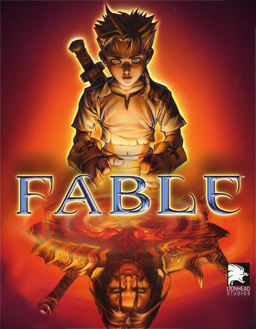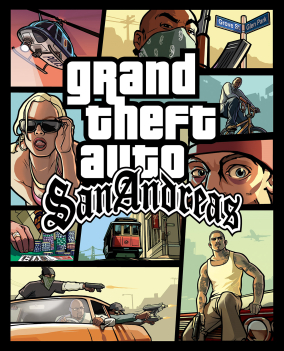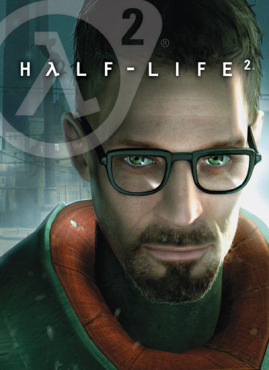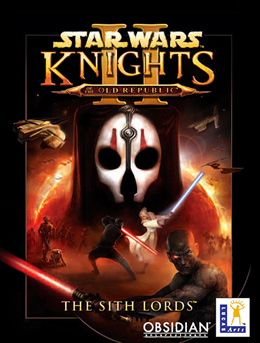These are good thoughts to have, and certainly aren't without merit. But as good as 2004 was, it wasn't that much better than the year before or the year after. A deconstruction may be in order.
Fable
Release Date: September 14, 2004.
Platform: XBOX/PC
ESRB Rating: M
Developer/Publisher: Lionhead Studios/Microsoft Game Studios
GameRankings: 85%
Completely Arbitrary Personal Score: 8.2/10 (Good)
Peter Molyneux, famous (or infamous) head of Lionhead Studios, has a penchant for being...possibly over-enthusiastic about his own games. This isn't something he does purposefully. He truly tries his hardest to make his games as good as he can. He just promises a little much, maybe. For instance, he once said that Fable would be "the greatest game ever made." While I'm sure there are some who hold that idea, I think most people would have to disagree. Twice now, Molyneux has apologized for not fulfilling promises made before the release of his games, and twice he has made the same promises for the next one. It's a level of enthusiasm that is generally a refreshment from the status quo as far as marketing goes.
As for the game itself, Fable was a clever little fantasy game filled to the brim with a sort of weary charm and a ridiculously in-depth social system. It was a common occurrence, at least for me, to lose a few hours to the game without actually advancing the plot. Not quite the "revolution" Molyneux promised, but still quite good.
Star Wars: Battlefront
Release Date: September 21, 2004.
Platform: XBOX/PS2/PC
ESRB Rating: T
Developer/Publisher: Pandemic Studios/LucasArts
Developer/Publisher: Pandemic Studios/LucasArts
GameRankings: 82.7%
Completely Arbitrary Personal Score: 7.5/10 (Above Average)
First things first: the Battlefront series is an unabashed copy of the Battlefield series with a Star Wars sheen. There is no mystery about this. The game itself is no more complicated. Simple, unit based combat over a variety of Star Wars themed maps, some of which are generic shooter fare, some of which are legitimately unique (Cloud City comes to mind), complete with every movie vehicle anyone could reasonably ask for. A single-player mode is there, but it's not anything to write home about (or in this case, blog about, I guess). What makes Battlefront a worthwhile experience is sitting down with a friend (or two or three) and engaging into some pure, straight, Star Wars chaos.
Grand Theft Auto: San Andreas
Release Date: October 26, 2004.
Platform: PlayStation 2
ESRB Rating: M (or AO)
Developer/Publisher: Rockstar
GameRankings: 95%
Completely Arbitrary Personal Score: 8.9/10 (Very Good)
Completely Arbitrary Personal Score: 8.9/10 (Very Good)
Who's in the mood for some Hot Coffee? Yeah, alright, me neither. Don't worry, I won't mention that stupid shit again. Worst. Scandal. Ever.
Let's talk about San Andreas, shall we? This game was the culmination of everything the other two PS2 games in the series had built to. It was, for lack of a better term, completely insane. Every batshit crazy situation you could possibly imagine can be re-created in San Andreas (and I mean EVERY). The sheer size, scope and selection of the game's mayhem filled world is still nearly unparalleled in the Sandbox genre. This size lent itself to a myriad of Rockstar's famous (or infamous) Easter Eggs (Bigfoot, anyone?).
Despite all of this, San Andreas has just as large and complex a storyline as it's predecessors, and also functions as a bit of a time capsule, capturing early 90s California in the same way GTA III captured late 90s New York and Vice City 80s Miami. It was the biggest and the best of the PS2-era Grand Theft Auto games.
Let's just say San Andreas was a good time. And a good game.
Let's talk about San Andreas, shall we? This game was the culmination of everything the other two PS2 games in the series had built to. It was, for lack of a better term, completely insane. Every batshit crazy situation you could possibly imagine can be re-created in San Andreas (and I mean EVERY). The sheer size, scope and selection of the game's mayhem filled world is still nearly unparalleled in the Sandbox genre. This size lent itself to a myriad of Rockstar's famous (or infamous) Easter Eggs (Bigfoot, anyone?).
Despite all of this, San Andreas has just as large and complex a storyline as it's predecessors, and also functions as a bit of a time capsule, capturing early 90s California in the same way GTA III captured late 90s New York and Vice City 80s Miami. It was the biggest and the best of the PS2-era Grand Theft Auto games.
Let's just say San Andreas was a good time. And a good game.
The Lord of the Rings: The Third Age
Release Date: November 2, 2004.
Platform: All Consoles
ESRB Rating: T
Developer/Publisher: EA Redwood Shores/EA
GameRankings: 77%
Completely Arbitrary Personal Score: 7.3/10 (Solid)
Completely Arbitrary Personal Score: 7.3/10 (Solid)
In most respects, The Lord of the Rings: The Third Age, is not a particularly good game. It's storyline flies in almost direct contradiction to the film series from which it is, canonically, supposed to be a part of it. It's characters are generally one note and uninteresting copies of characters from the Fellowship (an Elf and a Ranger and a Dwarf), and it's gameplay is almost directly lifted from various Final Fantasy games. I almost didn't put in on this list.
But why did I? It's simple, really. The Third Age steals from great things. It copies great characters. The sum of it's parts makes into something actually memorable. Plus I went through a rather large period where I considered literally any LOTR game to be a good experience. This game was easily the best of that crop. So here it stands.
But why did I? It's simple, really. The Third Age steals from great things. It copies great characters. The sum of it's parts makes into something actually memorable. Plus I went through a rather large period where I considered literally any LOTR game to be a good experience. This game was easily the best of that crop. So here it stands.
Halo 2
Release Date: November 9, 2004.
Platform: XBOX (later PC)
ESRB Rating: M
Developer/Publisher: Bungie/Microsoft Game Studios
GameRankings: 95%
Completely Arbitrary Personal Score: 9.3/10 (Great)
Completely Arbitrary Personal Score: 9.3/10 (Great)
I assume you're aware of this game. It might not have delivered upon it's initial promise (I only know one person who prefers Halo 2 to any of the other Halo games), but what it DID do was propel gaming to that next step beyond being a niche. Halo 2's release wasn't singularly responsible for this, but the fact remains that it's release date was the first gaming release seen as a major entertainment event. The game's online multiplayer mode set the groundwork for pretty much every console shooter to this date, and it, more than anything else, set up the "Halo-Killer" cliche that a great many games fell into, most notably the Killzone series.
As for the game itself, it was still a damned good game, maybe great, despite not really having a conclusion (for anyone who thinks otherwise, know that dialogue was recorded for a final level that Bungie never got enough time to finish). Much like another game on this list, Halo 2 could have used another 3-6 months to become the game it should have become.
Metroid Prime 2: Echoes
As for the game itself, it was still a damned good game, maybe great, despite not really having a conclusion (for anyone who thinks otherwise, know that dialogue was recorded for a final level that Bungie never got enough time to finish). Much like another game on this list, Halo 2 could have used another 3-6 months to become the game it should have become.
Metroid Prime 2: Echoes
Release Date: November 15, 2004.
Platform: Gamecube
ESRB Rating: T
Developer/Publisher: Retro Studios/Nintendo
GameRankings: 92%
Completely Arbitrary Personal Score: 8.7/10 (Very Good)
Completely Arbitrary Personal Score: 8.7/10 (Very Good)
Another game that, for whatever reason, isn't quite as good as it's direct predecessor is Metroid Prime 2. It's a natural progression from the plotline of the original, it's fun, challenging and legitimately interesting. It just isn't as good as the first one. Perhaps that's because the initial surprise of Metroid Prime was what gave it it's charm, perhaps because MP2 happened to come out in between two of the biggest game in history. Whatever it is, MP2 isn't at the same level of quality of MP. Also, the multiplayer, while seemingly a good idea, becomes pretty stale pretty quickly, and might have been better left on the cutting room floor.
Despite all that, it's still pretty damned good. Someday I need to play the third one.
Half-Life 2
Release Date: November 16, 2004.
Platform: PC (later XBOX and Xbox 360 through The Orange Box)
ESRB Rating: M
Developer/Publisher: Valve Corporation
Developer/Publisher: Valve Corporation
Half-Life 2 a game that amounts to more than the sum of its parts. And those parts are substantial. One part Orwellian superstructure, one part Logan's Run, Half-Life 2 takes the general sense of dread that permeates the original and elevates to a tangible tension that runs throughout the entire game, from the psychedelic beginning to the abrupt and disheartening ending. The gameplay itself draws inspiration from a myriad of genres and styles. Each individual chapter is almost it's own game (especially Ravenholm), and the physics engine is as sturdy and believable as any before or since.
Lastly, the sound. The music, by Kelly Bailey (who, sadly, left Valve last year) is subtle and disquieting, and the voice acting is top notch. The writing itself is rich and full of interesting language (see Dr. Breen's "Breencasts," the greatest example of Orwellian doublespeak outside 1984 itself. The wind whistles through ruinous bridges and abandoned homes, while City 17 itself seems to groan with the alien presence of the Citadel. It's an oppressive feel, on a large scale that never really leaves. Even the revolt in the game's final third feels nearly hopeless.
Really, at a certain point, there's nothing I can say that really describes my feelings and opinions about HL2. It's so far and away my favorite game that it's not even worth discussing. If you haven't played Half-Life 2, stop reading this and play it immediately. Seriously, it's cheap. The Orange Box is still sold in stores.
Metal Gear Solid 3: Snake Eater
Release Date: November 17, 2004.
Platform: PlayStation 2
ESRB Rating: M
Developer/Publisher: Kojima Productions/Konami
GameRankings: 91.9%
Completely Arbitrary Personal Score: 9.3/10 (Great)
Completely Arbitrary Personal Score: 9.3/10 (Great)
Metal Gear Solid 3, despite being a prequel, is the most forward looking and forward thinking installment of what is considered to be a particularly political series. Set during the height of the Cold War, a lot of the game's charm comes from 60s versions of Snake's iconic gear. Whimsy aside, Snake Eater is a serious game with a serious difficulty curve. The camouflage system, while extremely intuitive, is hardly unforgiving, and open combat is rarely an option outside boss fights.
The differences between Snake Eater and the first two MGS games are what makes Snake Eater the pinnacle of the series, in my opinion. The corridors and walkways of the first two games are replaced by a living forest environment, full of indigenous creatures (and foreign troops. With very deadly machine guns). Metal Gear Solid at it's best just happens to be Metal Gear Solid at it's least stereotypical.
Star Wars: Knights of the Old Republic II- The Sith Lords
Release Date: December 6, 2004.
Platform: XBOX/PC
ESRB Rating: T
Developer/Publisher: Obsidian Entertainment/LucasArts
GameRankings: 85%
Completely Arbitrary Personal Score: 8.8/10 (Very Good)
The second (and most tragic) file in the "Games From 2004 That Needed 6 More Months to be Completed" category is the sequel to the previous year's undisputed pinnacle. The Sith Lords (or TSL), was developed not by BioWare, but by Obsidian Entertainment, who at this point have a track record for producing worthy successors to someone else's masterpiece (2010's Fallout: New Vegas being the other entrant). TSL is, on the whole, a darker game than KOTOR, both in narrative and in setting. The dialogue takes a more moralistic, philosophical approach than Star Wars usually is known for, and it serves the game best when characters get to discuss the events of the first game and question the decisions made. Set five years after the original, the Jedi Order is on the brink of destruction, having been hunted there by a shadowy force whose motivations are still not entirely apparent at the game's conclusion.
Speaking of the conclusion, TSL's final act was largely cut from the game, at the behest of LucasArts, who demanded a late 2004 release. A few noble groups have endeavored to restore what they can from the game's files to the PC version (Team Gizka being the most popular), but the fact remains that TSL might always been remembered more for what it should have been over what it is, which is a shame.
Completely Arbitrary Personal Score: 8.8/10 (Very Good)
The second (and most tragic) file in the "Games From 2004 That Needed 6 More Months to be Completed" category is the sequel to the previous year's undisputed pinnacle. The Sith Lords (or TSL), was developed not by BioWare, but by Obsidian Entertainment, who at this point have a track record for producing worthy successors to someone else's masterpiece (2010's Fallout: New Vegas being the other entrant). TSL is, on the whole, a darker game than KOTOR, both in narrative and in setting. The dialogue takes a more moralistic, philosophical approach than Star Wars usually is known for, and it serves the game best when characters get to discuss the events of the first game and question the decisions made. Set five years after the original, the Jedi Order is on the brink of destruction, having been hunted there by a shadowy force whose motivations are still not entirely apparent at the game's conclusion.
Speaking of the conclusion, TSL's final act was largely cut from the game, at the behest of LucasArts, who demanded a late 2004 release. A few noble groups have endeavored to restore what they can from the game's files to the PC version (Team Gizka being the most popular), but the fact remains that TSL might always been remembered more for what it should have been over what it is, which is a shame.





.jpg)



No comments:
Post a Comment